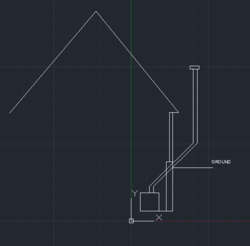Hi all,
I'm new to the forum, but I have heated with wood since I was little. We now have a house that doesn't have a chimney, and we bought an Englander (2200 sq ft model) wood stove from home depot. I have a free source of wood if I just split it, as well as probably a years worth of old hardwood board trimmings to burn, and pin oak pallets. We figure that'll save a good amount of heating money.
Anyway, we need to put in a stainless chimney. We are putting the stove in the basement, as it is really the only spot we have a good spot for it. Plus heat will rise and we can draw air through our current central heat system by just running the blower.
The problem (or maybe not?) I have is running the chimney due the very steep angle of the roof. I have seen that the cap of the chimney should be 2 feet above the nearest point of the roof 10 feet away. For example, if I ran it straight through the house, it'd have to be over 35 feet tall to achieve that. That being said, the current plan is to put the stove a foot or so from the basement wall (block), and run one 45 degree fiting through the wall, and another just as it gets about 5 feet from the side of the house, and straight up from there. I plan on using double or triple wall stainless, if it makes a difference.
I'm looking for some confirmation that this will work, or suggestions on what to do to make it better.
Thanks a lot,
Mike
I'm new to the forum, but I have heated with wood since I was little. We now have a house that doesn't have a chimney, and we bought an Englander (2200 sq ft model) wood stove from home depot. I have a free source of wood if I just split it, as well as probably a years worth of old hardwood board trimmings to burn, and pin oak pallets. We figure that'll save a good amount of heating money.
Anyway, we need to put in a stainless chimney. We are putting the stove in the basement, as it is really the only spot we have a good spot for it. Plus heat will rise and we can draw air through our current central heat system by just running the blower.
The problem (or maybe not?) I have is running the chimney due the very steep angle of the roof. I have seen that the cap of the chimney should be 2 feet above the nearest point of the roof 10 feet away. For example, if I ran it straight through the house, it'd have to be over 35 feet tall to achieve that. That being said, the current plan is to put the stove a foot or so from the basement wall (block), and run one 45 degree fiting through the wall, and another just as it gets about 5 feet from the side of the house, and straight up from there. I plan on using double or triple wall stainless, if it makes a difference.
I'm looking for some confirmation that this will work, or suggestions on what to do to make it better.
Thanks a lot,
Mike


